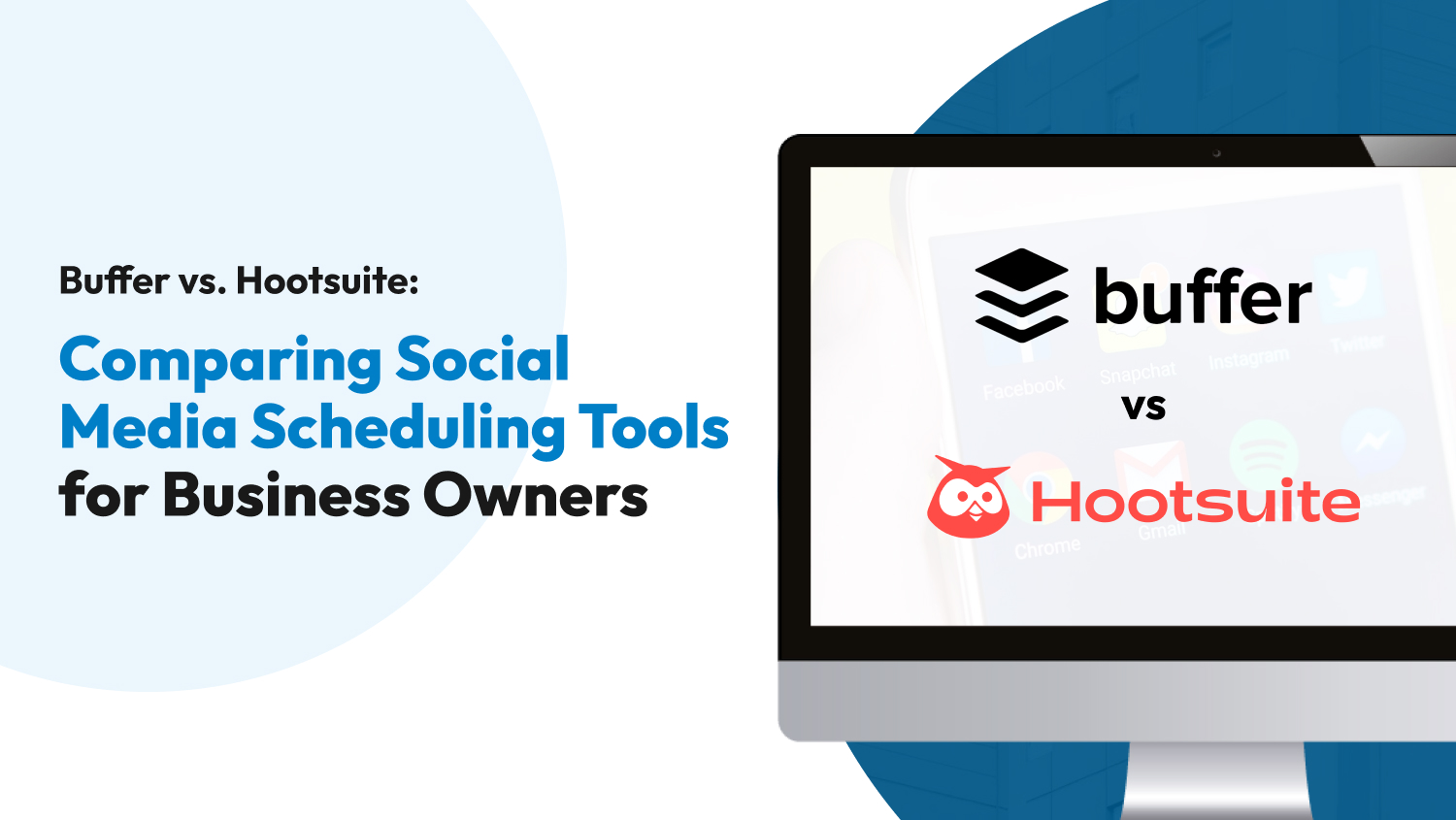Business
Buffer vs. Hootsuite: Comparing Social Media Scheduling Tools for Business Owners
According to an in-depth report by Kepios, more than 59% of the human population uses social media, and we spend an average of 2.5 hours browsing content online. For businesses, this means you must spend significant amounts of your resources on an efficient and automated social media campaign.
Fortunately, there are plenty of excellent social media tools for businesses. For instance, Buffer and Hootsuite are two industry-leading social media schedulers packed with features for a reasonable price. However, these tools have specific features that make them perfect for a particular business. The only question is, which one’s perfect for you?
Let’s find out.
Buffer vs. Hootsuite: The Social Media Scheduler Face-Off
To make a well-informed decision, we must first establish the metrics to compare Buffer and Hootsuite. This will allow you to identify the strengths and weaknesses of each scheduler and pick a tool based on reliable criteria. For Buffer and Hootsuite, we’ll use the following:
- Usability
- Content Creation and Management
- Publishing
- Communication and Reach
- Analytics
- Third-Party Integrations
- Cost
So, let’s get started.
Usability
Good usability separates effective software from its market counterparts in today’s digital landscape. Without a smooth user experience, you may experience a decrease in your productivity levels and frustration in using the software.
For social media tools, Buffer has a more minimalist and straightforward interface. It’s also easy to set up, and publishing content is a breeze, which we’ll discuss in depth later.
On the other hand, Hootsuite is more complex and has a steep learning curve due to its rich feature set. Once you master Hootsuite, you can curate your dashboard only to show what you need. If you need clarification while using the application, Hootsuite also offers an extensive help center where you can access how-to guides and articles.
Winner: Buffer (1-0) takes an early lead.

Content Creation and Management
Content creation is the cornerstone of every social media scheduler. It must provide enough editing tools for production and connections to the most prominent social media platforms.
Buffer refers to their supported social media applications as “channels.” These are the following platforms they can connect to:
Meanwhile, you can also integrate Hootsuite with all those and more. Thanks to its integrations, you can connect to sites like WordPress, Vimeo, Tumblr, Reddit, and YouTube without a hitch.
As for content creation, Hootsuite is equipped with the Canva editor, which makes for better-looking infographics, and Grammarly for well-written posts and captions. On the other hand, Buffer has an editing tool called Pablo, which is excellent but less extensively equipped than Canva.
Social media engagement is also made more accessible in Hootsuite, as you can respond to posts in Hootsuite via reacts, comments, or reposts.
Winner: Hootsuite ties it up at 1-1.
Publishing
A significant part of your content creation is a publishing schedule. For a social media tool to be effective, it must offer efficient automation for your content.
Let’s start with the similarities. Both Buffer and Hootsuite offer scheduling functionalities for your posts. Moreover, you can create a publishing schedule in both tools, slightly tweak your scheduled posts, add different images for each post, and publish on multiple social media platforms simultaneously.
Buffer’s publishing automation is called Buffer Queue. With it, you can schedule posts for up to a month or set specific intervals for each post. You can also change the publishing schedule assigned by Buffer if you want to.
As for Hootsuite, its publishing automation is named AutoSchedule. This feature gives complete control to Hootsuite if you want an automated schedule. Hootsuite takes your posts, analyzes your key demographic, and publishes content at the optimal time according to their algorithms.
Winner: If you value autonomy, pick Buffer. If you want complete automation, you’re better off with Hootsuite. Due to its similarities, this category is a tie.
Communication and Reach
No matter the business, communication between you, your team, and audience is crucial to the efficiency of your business.
For communication, Hootsuite is the clear winner. Buffer used to offer a customer messaging app called Buffer Reply, but it’s been discontinued. Hootsuite, on the other hand, allows conversations to be conducted in-app. You can conveniently view and reply to all the messages you receive across your social media accounts in Hootsuite. Moreover, you can also conduct team meetings in Hootsuite, making for a more streamlined work process.
For reachability, Hootsuite also has Hootsuite Ads, which uses post customization, geolocation data, and engagement statistics for lead generation and conversion. The only caveat is that it’s a paid feature.
Winner: Hootsuite leads 2-1.
Analytics
In entrepreneurship, awareness is critical to ensure you’re running a successful social media campaign. That’s why analytics are an essential asset for a thriving business.
Buffer offers the following for analytics:
- Engagement: How many people viewed and reacted to your posts.
- Insights: The reasons your business is or isn’t performing to your expectations.
- Post Performance: Audience engagements on a specific post.
- Time To Post: The optimal time to publish to maximize audience interaction.
On the flip side, Hootsuite claims they’re the best in analytics for its social media management tools. And, so far, it’s walking the talk.
Hootsuite already offers everything that Buffer has for analytics. On top of that, the application also has the following:
- Better Visualization: For better understanding and informed decision-making.
- Competitive Benchmarking: How well your social media campaign performs against other businesses.
- Paid vs Organic: Statistics on how well your posts vs. automated posts perform.
What separates Hootsuite from other social media tools in analytics is a feature called “Goal-Based Analytics.” This allows your statistics to create optimized content for better engagement. You can set your goals as any of the following:
- Build Awareness
- Drive Traffic
- Extend Reach
- Increase Engagement
Winner: With another point, Hootsuite takes a commanding lead at 3-1.
Third-Party Integrations
To maximize your social media tool, it must connect to as many apps as possible. This allows your social media scheduler to unlock more features it wouldn’t otherwise have in its base version.
Buffer offers 28 native integrations, including prominent applications such as:
- Feedly
- IFTTT
- Microsoft Suite
- WordPress (Legacy)
- Zapier
Its connection to IFTTT and Zapier also allows indirect integration with other software, such as marketing apps like ActiveCampaign, and productivity apps like ClickUp. That said, nothing beats native integration.
Meanwhile, Hootsuite allows native integration to more than 200 app, including:
For a full list of integrations, you can view Hootsuite’s list here and Buffer’s list here.
Winner: No question, Hootsuite (4-1) wins this category by a mile.

Cost
Now, let’s talk about pricing. It’s important to check whether Buffer or Hootsuite fits your allotted budget, so you can enjoy a bigger ROI. Let’s discuss the options these tools offer.
Buffer
Buffer’s cost scales with how many social media channels you integrate with it. The cost of its plans with the features they offer are:
| Features | Free | Essentials | Team | Agency |
| Cost | Free | $6/month per channel | $12/month per channel | $120/month per channel; $6/month per channel after 10 channels |
| Users | 1 | 1 | Unlimited | Unlimited |
| Channels | 3 | Unlimited | Unlimited | Unlimited |
| Maximum Queued Posts Per Channel | 10 | 2,000 | 2,000 | 2,000 |
Hootsuite
On the other hand, Hootsuite has fixed prices for each of its tiers. It doesn’t have a “Free” tier; instead, it has a free 30-day trial for its “Professional” and “Team” tiers. You can see a full list of their plans below:
| Features | Professional | Team | Business | Enterprise Custom |
| Cost | $99/month | $249/month | $739/month | Custom |
| Users | 1 | 3 | 5 | Minimum of 5 |
| Channels | 10 | 20 | 35 | Minimum of 50 |
| Maximum Queued Posts Per Channel | Unlimited | Unlimited | Unlimited | Unlimited |
Winner: Buffer (4-2) scores a late win.
Final Thoughts
The results are in, and Hootsuite wins our comparative review of social media schedulers at 4-2. However, it’s not up to us what you choose. In fact, both these tools have their specific demographic, and the choice should be based on your business’s needs. So, list your marketing specifications, and we’ll give you a quick rundown of where each tool shines.
Buffer is perfect if you’re looking for a cost-effective solution to your publishing needs. For new or small businesses, creating a schedule for your posts is a quick process in Buffer, thanks to its user-friendly interface. So if your social media presence exists on platforms like Facebook, Instagram, Tiktok, or Twitter, Buffer will satisfy you with its rich feature set.
However, if you require a full social media marketing suite, Hootsuite is the perfect tool for your business. Its extensive toolkit allows you to automate your posts, create beautiful content, execute analytics-influenced marketing strategies, and engage with your audience better. Even entrepreneur and marketing coach Maria Gavriel recommends Hootsuite.
When all is said and done, you call the shots. But we guarantee your social media campaign will be made easier, whichever scheduling tool you pick. In fact, we recommend both these tools for effective virtual assistant management. So make a choice and good luck!











